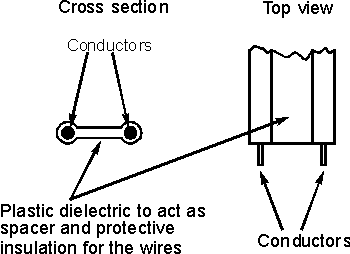- including open wire, two-wire, twin, and ribbon feeders
Balanced feeder is a form of feeder that can be used for feeding balanced
antennas (i.e. antennas that do not have one connection taken to ground). It is
mainly used on frequencies below 30 MHz can offer the advantage of very low
levels of loss. The feeder or transmission line is also referred to by other
names including twin, two wire, open wire, and sometimes even ribbon feeder.
These names often depend upon the type of construction of the particular form.
It is used less than coaxial feeder or coax, although it is able to offer
some significant advantages over coax in some applications.
Basics
A balanced or twin feeder consists of two parallel conductors unlike coax that
consists of two concentric conductors.. The currents flowing in both wires run
in opposite directions but are equal in magnitude. As a result the fields from
them cancel out and no power is radiated or picked up. To ensure efficient
operation the spacing of the conductors is normally kept to within about 0.01
wavelengths.
The feeder exists in a variety of forms. Essentially it is just two wires
that are closely spaced in terms of the radio frequency of operation. In
practical terms manufactured feeder is available and it consist of two wires
contained within a plastic sheath that is also used as a spacer between them to
keep the spacing, and hence the impedance constant. Another form commonly called
open wire feeder simply consists of two wires kept apart by spacers that are
present at regular intervals along the feeder. It has an appearance a little
akin to a rope ladder.

Twin feeder a form of balanced feeder
Impedance
Like coaxial cable, the impedance of twin feeder is governed by the dimensions
of the conductors, their spacing and the dielectric constant of the material
between them. The impedance can be calculated from the formula given below.

Where
D is the distance between the two conductors
d is the outer diameter of the conductors
Epsilon is the dielectric constant of the material between the two conductors
Types
This type of feeder can take a variety of forms. An "open wire" feeder can be
made by having two wires running parallel to one another. Spacers are used every
fifteen to thirty centimetres to maintain the wire spacing. Usually these are
made from plastic or other insulating material. Typically this feeder may have
an impedance of around 600 ohms, although it is very dependent upon the wire,
and the spacing used.
The feeder may also be bought as flat 300 ohm ribbon feeder consisting of two
wires spaced with a clear plastic. This is the most common form and is the type
that is used for manufacturing temporary VHF FM antennas. If used outside this
type absorbs water into the plastic dielectric. Not only does this significantly
increase the loss on damp days, but the moisture absorbed causes the wire to
oxidise which in turn leads to increased losses over the longer term.
The feeder can also be bought with a black plastic dielectric with oval holes
spaced at intervals in spacing. This type gives far better performance than the
clear plastic varieties which absorb water if used outside.